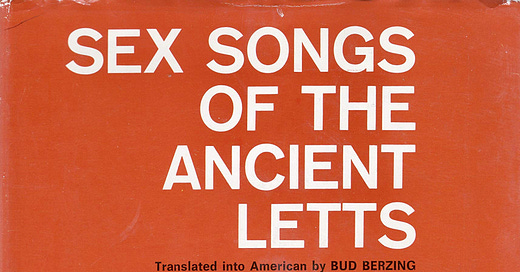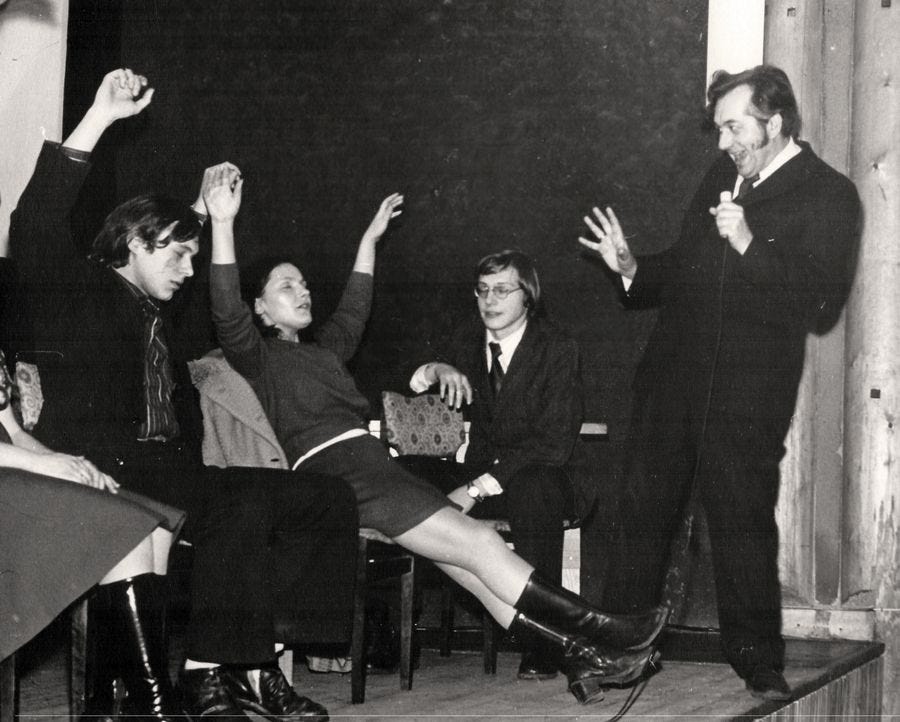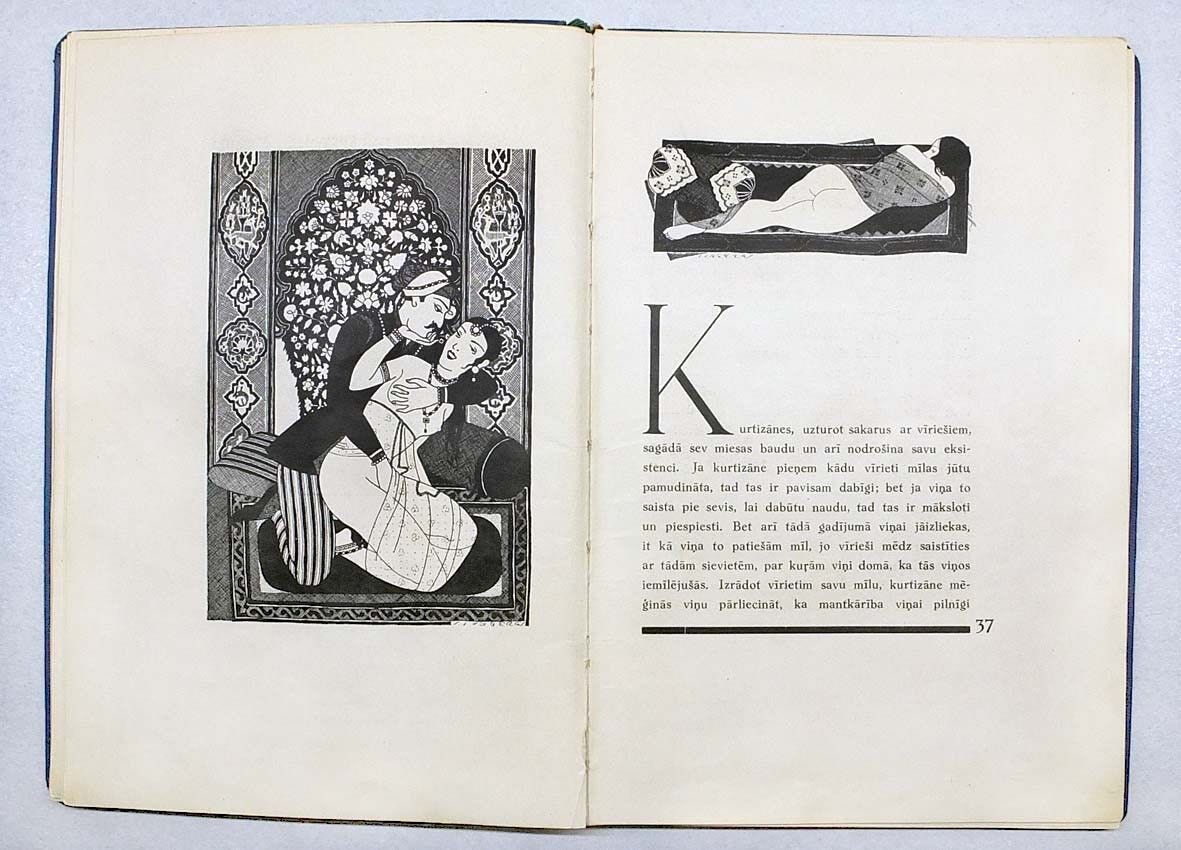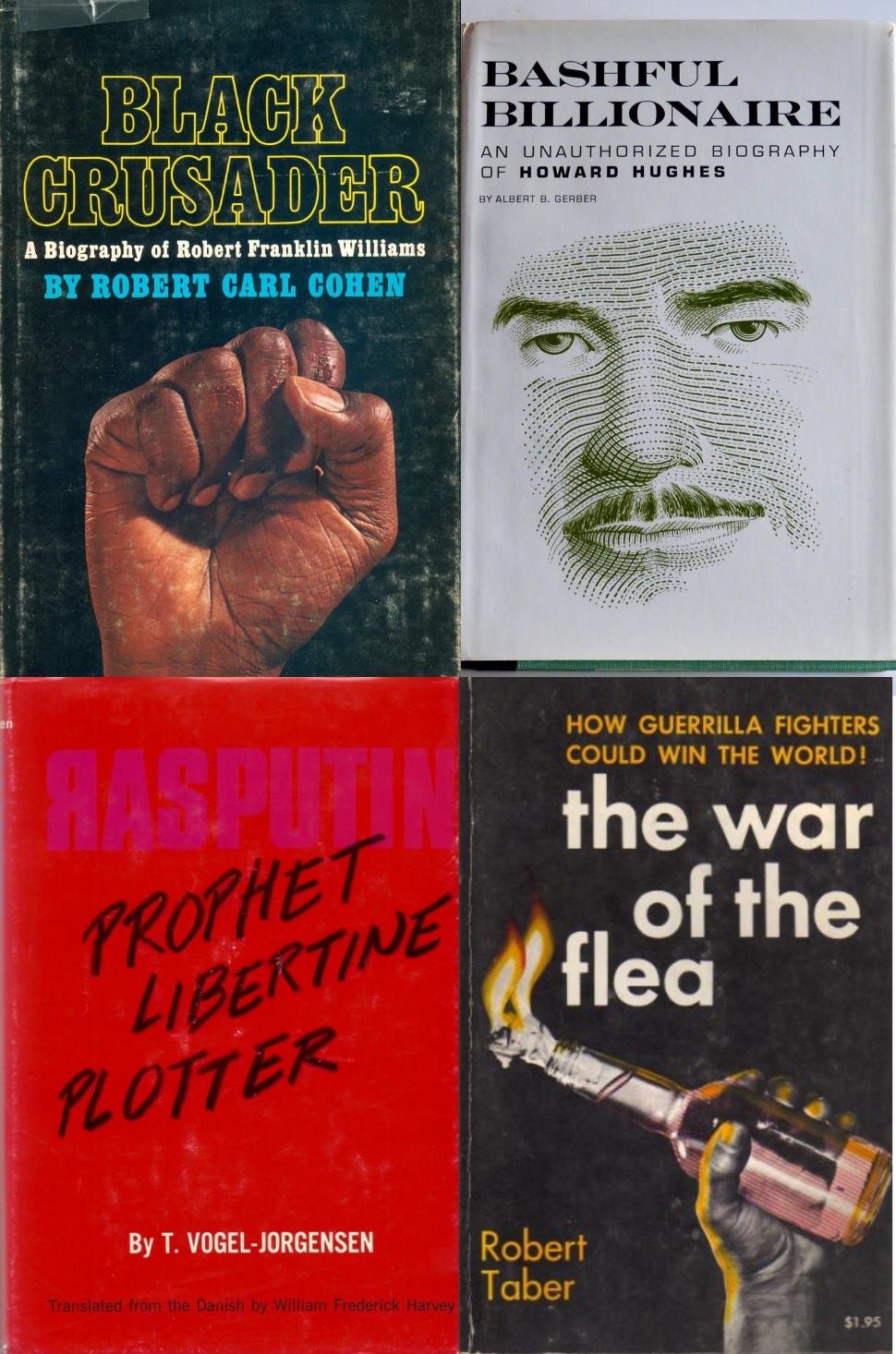NOTE: The post below is largely based on the outside of the book. In other words, a judgement by its cover. I’ll address the inside in my next post.
For the last two years I've been writing a book about Latvia. Although I've got some background in Soviet, Russian and Polish history, I'd never given the place much consideration before. I couldn't name a Latvian city other than Riga. It was a place that flickered into view towards the borders or in other histories. So I needed to research and that meant books.
Some of these I could find online. Others appeared more providentially. I thought I'd write about some that I’ve found useful (or not) along the way. By far the most lubriciously titled is this one:
SEX
Is there such a thing as Latvian sex? The world population of Latvians, modest thought that may be, indicates yes. It makes me think of the running gag in Polanski's Chinatown about the husband “screwing like a Chinaman”. Is anyone ever accused of making love like a Latvian? That I don't know.
As for Latvians and sex, this book proposes they are, or were, very open minded about it. Both Christianity and Communism may both have done their bit to affect things, but the pagan Latvian of former times, untouched by these foreign invasive ideologies, thinks of sex as something joyful between milking a cow and bringing in the sheaves. At least, that would seem to be the suggestion herein.
One Soviet Latvian book from 1981 worth mentioning here is Mīlestības Vārdā (In the Name of Love) by Jānis Zālītis. Formally, the Soviet Union was prudish about sexual matters. Some around the time of the revolution, such as Alexandra Kollontai, had sought to make sexual liberation a cornerstone, but these tendencies were neutralised. Homosexuality was recriminalised under Stalin in 1933 after a brief breather of relative legality. Sex was something for marriage. Otherwise it was potentially deviant, if not criminal, and it might need treatment and possibly incarceration.
Was this the reality? No. Sex is too much to be contained. The perceived danger of Soviet youth cultures, such as the stilyagi jazzers and later hippies, was in part the threat of sex as something that might destabilise order. Were the Young Pioneers or Komsomol having sex? I don't doubt it happened but they kept it on the QT. Moreover, there may be a sexual ideology central to the Soviet Union, concocted somewhere or another, but its practice and enforcement is a different matter, particularly in contested cultures and peripheries such as Latvia.
The first edition of this sex guide included hazy David Hamilton-esque photography by Jāņis Gleizds, whose rural sylvan settings echo the Sex Songs. The 99,000 copies soon sold out. For the second, more practically minded illustrations by Edgars Ozoliņš were added. This was a step too far for the censors and the edition was withdrawn and pulped.
Although he was keen for Latvians and others to be having healthy, happy sex, Zālītis maintained the line on homosexuality as deviant. In other work on Tchaikovsky, he was adamant that there was no indication of any such tendencies in the composer's life or work.
Fifty years earlier in 1931, and with a modest print run of four hundred and one, Sigismunds Vidbergs had illustrated an edition of the Kama Sutra. In 1928, he had illustrated a Latvian translation of Pierre Louÿs’ Les Chansons de Bilitis.
Much of Vidbergs' work suggests an erotic potential to the Latvian capital in this interwar period. A sophisticated dissolution largely unavailable to those in the countryside beyond. Vidbergs was a prodigious illustrator for Latvian publishing of this period and also part of the Baltars ceramics group with Romans Suta and Aleksandra Beļcova, which also connects to the “Latvian Mata Hari", Austra Ozoliņa-Krauze, but let's not get distracted... As if.
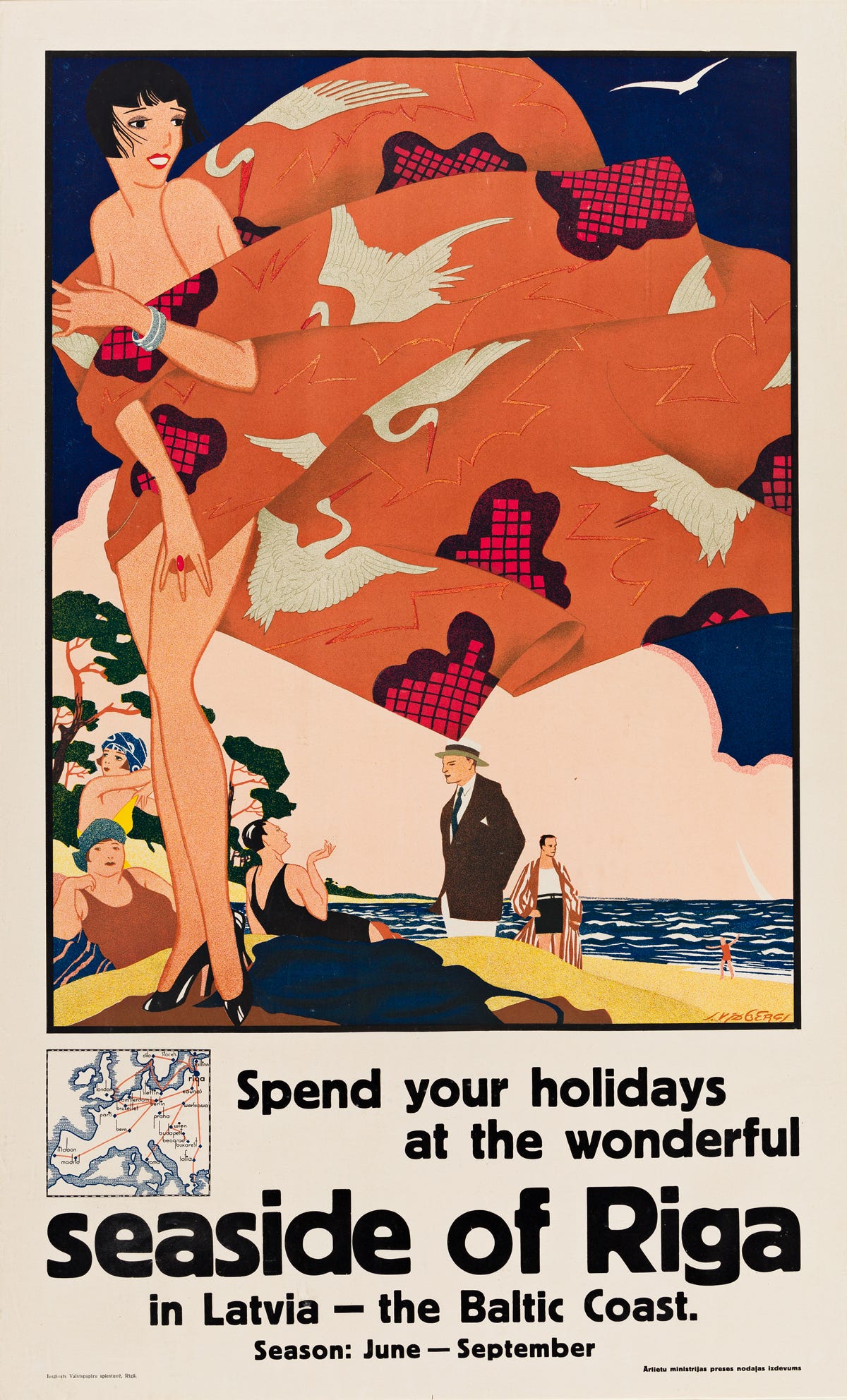
SONGS
Singing plays an intrinsic part in Baltic history. The insurrection and resistance against the Soviet Union in the late 1980s that led to the restoration of independence for Estonia, Latvia and Lithuania became known as the Singing Revolution. Some of the material heard at the various demonstrations pre-dated Soviet occupation, other songs were more recent compositions. The level and nature of national, political or sexual expression that might interpreted in any given song performed in concert or transmitted had to be considered. What can you get away with? What will get you in trouble?
One well-known Latvian example is the 1899 song Gaismas pils (Palace of Light) based on a folk tale about a sunken castle that will one day rise again. Music by Jāzeps Vītols, text by the poet Auseklis (Miķelis Krogzemis). This was performed at the All-Latvian Song Festival in 1910 and became a fixture on the programme at subsequent song festivals in both independent Latvia and then will it or won’t it appearances in the later Soviet period because of its spirit of national resurrection. See the below for a subtitled overview of these festivals and this song.
It was dropped again at the 1985 festival which marked the 40th anniversary of Soviet liberation. That exclusion wouldn't do. At the closing ceremony, many in the audience called upon the conductor Haralds Mednis to perform it anyway. He had been made to sit this festival out in the audience but rose to the occasion.
The song itself starts around the four minute mark, but it's worth watching for the build up as the crowd think it's all over, but... Some sing. Others do not.
Just as the song's initial performance at the festival in 1910 presaged Latvian independence in 1918, so did this occasion in 1985 foreshadow its second restoration in 1991. Soviet censorship and control of artistic production is - of course! - rather complex so I'm going to avoid getting into that here. Suffice to say that this type of mass event televised to the nation demanded much tighter strictures over repertoire. Gorbachev is just a few months in power and Poland is far from pacified following martial law.
(All well and good, you may be thinking, but I really wanted to get on with some Latvian sex! Well, you're just going to have work through some more background. This is the way.)
Gaismas pils, however Latvian in content and creation, is not a folk song, let alone an ancient one. What are those? Here in the UK, it's Cecil Sharp (1859-1924) who is the best known of the folk song collectors, both in England as well as Appalachia. In Latvia, it's Krišjānis Barons (1835-1923) whose project amassed 217,996 Latvian folk songs. These are known as daina(s) or tautas dziesma. These were published from 1894 to 1915 in the six volume Latvju Dainas.
Blimey, I thought on first encountering that number, that is a lot of songs. As it turns out, the vast majority of these are quatrains. Just the four lines. Barons stored these in one of the most totemic of Latvian cultural objects, the Cabinet of Folksongs (dainu skapis), the original of which now resides in the National Library of Latvia in Riga. A building - by the way - also known as Gaismas pils or Palace of Light. The contents of the drawers are now digitised. The slips of handwritten text are about the size of a slim kingsize Rizla which is not entirely coincidental as Barons had first used empty boxes of the Russian papirosy cigarettes he smoked for storage.
ANCIENT LETTS
There's not so much information about the book's authors online, but one very intriguing suggestion you find is that (Bud) Berzing is a partial anagram of Ginzberg and therefore, just maybe, actually the poet Allen Ginsburg. What?!? In a 2011 post on a pretty knowledgeable Ginsburg blog:
"...Only trouble is there never was such a civilization as the Letts, Berzing and Eglis don’t exist, and the whole thing is a hilarious hoax! perpetrated by… Berzing? Ginsberg? – several have suggested that the pseudonymous author was Allen."
Hold your damn horses there, city boy. These days some might call this Latvian erasure. Let's have a quick refreshment of what and where Latvia is. The present day country is divided into four regions: Kurzeme, Zemgale, Latgale and Vidzeme. In Latin, these were known as Curonia, Semigallia, Latgallia and (sort of) Livonia. In German, they are Kurland, Semgallen, Lettgallen and (sort of) Livland. There have been a number of competing and invasive interests for this territory such as the German Crusaders of the Teutonic Order, the Hanseatic League, Poland and Lithuania, Sweden and Russia. Various duchies and partitions come and go.
Latvia takes its name from Latgale. Its language is Latvian. Were there once languages such as Curonian, Semigallian, Latgallian and Livonian? Yes. Livonian is a Finnic language and therefore relates to Estonian. Latgallian is these days its own language spoken in eastern Latvia.
NOTE: Latvian is a Baltic language. So is Lithuanian. There is also Latgallian, as mentioned, and Samogitian, spoken in western Lithuania. Present day Latvian and Lithuanian are not considered mutually intelligible. Enough shift and change has happened to each language that direct conversation is tricky. See also Estonian and Finnish. Linguistics has a Balto-Slavic group but Latvian is NOT a Slavic language. As a Russian and Polish speaker, I can see certain words from time to time in context and guess meaning correctly if I’m lucky, but it's not that common.
I almost forgot, here's a map. Hang on a minute, what's Sēlija doing there? Well, this region, Selonia in Latin, is considered one of the five historic regions of Latvia. About half of historic Sēlija is now in Lithuania. Its Latvian segment is swallowed into adjacent regions.

Latvia is still called Lettland in German and Lettonie in French. It's not that unknown a term. True, there was never an independent nation of Lettonia, but there was assuredly civilisation in the region. I don’t get why the Ginsberg blog is so assured here. I'm reminded of the 1993 Seinfeld episode in which George converts to Latvian Orthodoxy. The episode writer Bruce Kirschbaum presumably wanted come up with some imaginary religious group as he also came up with an imaginary Latvian word - kavorka - for "the lure of the animal".
(But there is indeed Latvian Orthodoxy. For most of its history, Eastern Orthodox Christianity in Latvia has of course been via the Moscow Patriarchate and hence Russian, but the Bolshevik Revolution lead to the establishment of an autonomous Latvian Orthodox Church in newly independent Latvia. Just last year in 2022, in a process accelerated by Russia's invasion of Ukraine, the Latvian Orthodox Church declared autocephaly.)
I don't think there's any slur intended. It's just that Latvia is pretty much unknown. Almost, but not quite, a Ruritania, Syldavia or even Sylvania. If someone wanted to confect a series of purportedly authentic folk songs, Latvia - or the Letts - would be a decent candidate. After all, who would be around to criticise that? Well, potentially the Latvian emigré population of New York and elsewhere in America and Canada. The cultural centre of Latvia House at Park Slope, Brooklyn, has gone, but there's still a Latvian language newspaper Laiks that dates from 1949 as well as the literary and cultural review Jauna Gaita published from 1955. There was also a not insignificant number of Latvian artists active in New York, such as the so-called Hell's Kitchen collective.
It's very possible that Allen Ginsburg might have crossed paths with some of these people on the scene and had a conversation about poetry and folk song. Harry Smith, the polymath collector behind the Folkways Anthology of American Folk Music and associate of Allen, must have heard Latvian folk music at some point. Maybe this 1966 release below by American Latvians even. Can I imagine some pot fuelled evening of merriment where Allen, Harry and others joke about faking a tradition? Absolutely. Do I imagine them going through with it when sober? Less so. Do I think this is what Sex Songs of the Ancient Letts is? No.
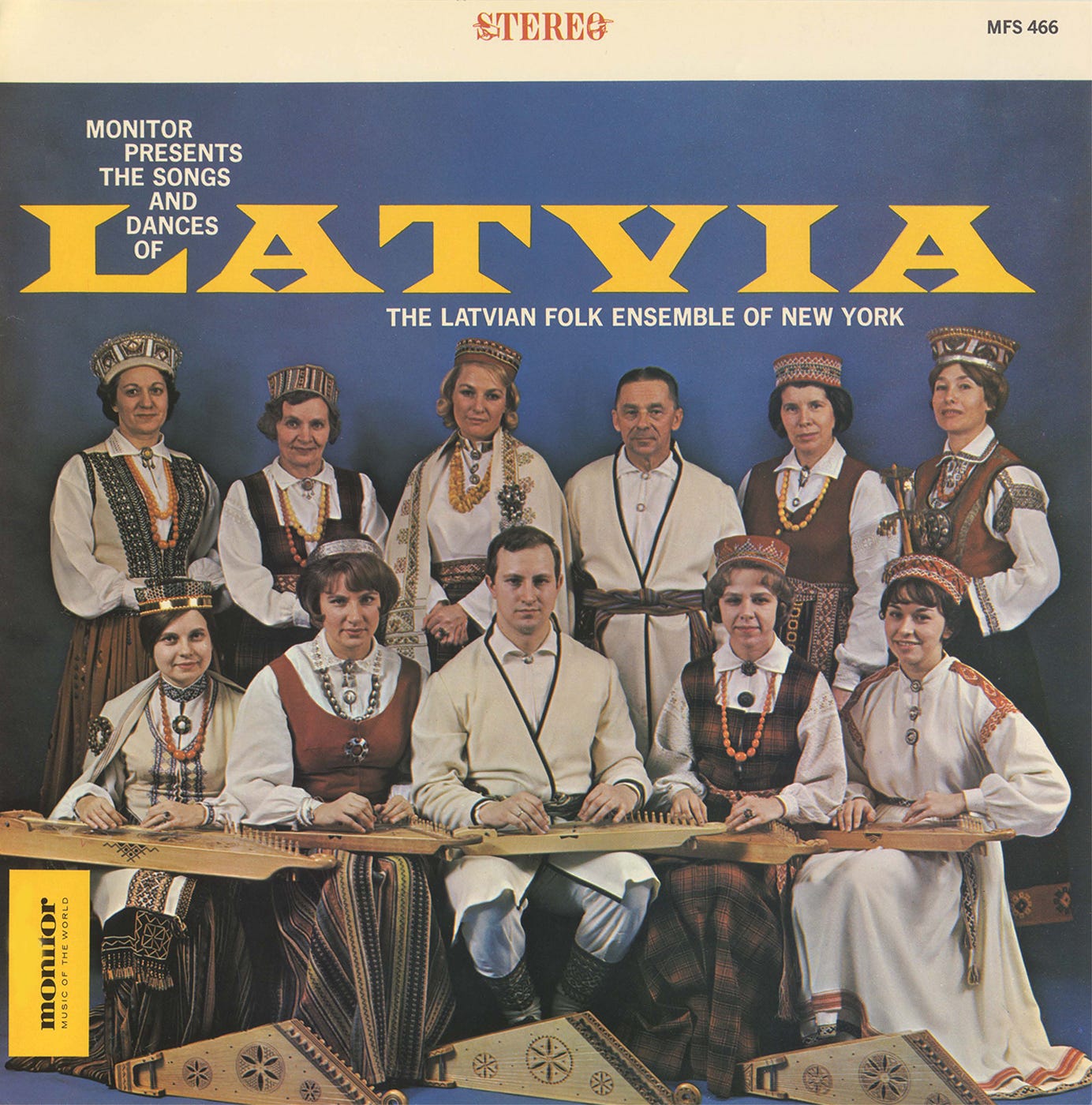
Berzing is not really a convincing anagram of Ginsburg unless stoned. It's much closer to the very common Latvian surname of Bērziņš. The translator of the Kama Sutra mentioned above, Rihards Bērziņš, is one of many well-known Latvians with this surname. It's pretty much a Latvian Smith or Jones. Bērzs is birch in Latvian (bereza/береза in Russian) and given that tree's presence throughout Latvia and neighbouring regions, a common source for names, such as the town of Byerazino/Беразіно́ in Belarus. Numerous Berzings are listed on ancestry websites as are Behrsing, Behrzing, Berezin and others.
The Ginsberg blog goes on to suggest another candidate. Tuli Kupferberg of The Fugs. This is an inspired choice - I want to believe - but I really don't see it. Once you realise that these poems do in fact exist, it follows they will need translation from the original Latvian. Neither Ginsberg nor Kupferberg can do that but might they have done some polishing? That is not impossible, but neither is it likely.
Bud Berzing is a dead end beyond this book. Who then is Arsene Eglis? There's not much about him either, but there are a few glimpses of persons unknown who share that name:
1958 - He pops up in the November issue of Sexology (Vol. 25 No. 04, pp 246-249) with the article "Sex in Folksongs". Other articles include: How dangerous Are 'Sex Criminals'? by Frank S. Caprio and Donald Bremmer, Why I Am a Rubber Fetishist, by L.A.M., Birth Control Pills - A Progress Report by Isidore Rubin and Sex Behavior of Delinquent Girls.
1959 - In Vol. 15, No. 3 of Herpetologica, one Arsene Eglis of "41-72 Denman, Elmhurst 73, N.Y., desires correspondence on Homopus in captivity."
1960 - In Vol. 16, No. 1, pp 12-14, of Herpetologica, he contributes "Notes on the Soft-Shelled Tortoise Malacochersus tornieri (Siebenrock)"
1962 - Again in Herpetologica, "Tortoise Behavior: A Taxonomic Adjunct", Vol. 18, No. 1, pp. 1-8.
1965 - The French cryptozoologist Bernard Heuvelmans publishes "Histoire des bêtes ignorées de la mer. Le grand serpent-de-mer, le problème zoologique et sa solution" (Librairie Plon) and Arsene Eglis of Elmhurst is mentioned in the Remerciements.
1967 - Issue 16 of Radio Liberty research papers includes "Soviet News Media and the Middle East Crisis: A Chronological Review of Soviet Coverage" with Olivia Gilliam.
1973 - Fate Magazine (April, Vol. 26, No. 4) includes this review by Arsene Eglis of Carry On Talking by Peter Bander, a book about electronic voice phenomena (EVP) and in particular the fellow Latvian Konstantīns Raudive's work in the field.
Are these all the same Arsene Eglis? Quite possibly. An interest in reptiles that includes speculative cryptozoology and the esoteric? The Middle East Crisis possibly sticks out a little here, but the Latvian emigré community have on the whole been enthusiastic supporters of anti-Soviet endeavours such as Radio Liberty and potentially a knowledge of Russian made him useful here. I think the author of above and translator/editor of the Sex Songs could all be one singular person.
Sex Song’s publisher University Books had no ties to any university. The press had been founded by the communist Felix Morrow in 1950s, known for his writing on the Spanish Civi War. With factionalist infighting, state persecution and perhaps sensing something headier on the wind, Morrow decided it was time to ditch the Fourth International for the Fourth Way. University Books specialised in the esoteric, occult and alternative as did Morrow’s other imprint Causeway Books.
University Books also ran the Mystic Arts Book Club, which is variously cited as a significant force in the occult revival of the period. One free gift upon signing up was a reprint of the A.E. Waite tarot deck, which now included mention of the artist Pamela Colman Smith who had done the work, whereas the original Rider edition in 1909 had omitted her involvement.
There’s not too much information about Morrow and University Books I can find other than in a prologue to an edition of Montague Summers’ The Vampire: The Vampire: His Kith and Kin (pp. xxviii-xxxii) where Morrow’s role in ushering in the Age of Aquarius is attested. It seems running the Mystic Arts Book Club had been a significant financial misjudgement. University Books were sold to the publisher Lyle Stuart in 1966.
I’m fairly astonished there’s no tv biopic or similar about Lyle Stuart. At least a biography. His life reads like a missed opportunity for a Mad Men-alike look at the world of publishing in a vanished age of bylines before online takes over. It’s not high culture. It’s controversy, gossip and sensation that sells. Maybe it’s early clickbait. It is an approach that seems founded on the idea of a free press that doesn’t give a damn about its posterity or your opinions.
So he publishes The Anarchist Cookbook as well as A Nation Saved: Thank You, President Reagan, lurid biographies such as Poor Little Rich Girl (Barbara Hutton) and Jackie Oh!, confections like Naked Came The Stranger and The Sensuous Woman as well as Fidel Castro, Yukio Mishima, Timothy Leary, Charles Bukowski and not forgetting Sex Songs of the Ancient Letts, which I doubt was one of his best selling titles over the years.
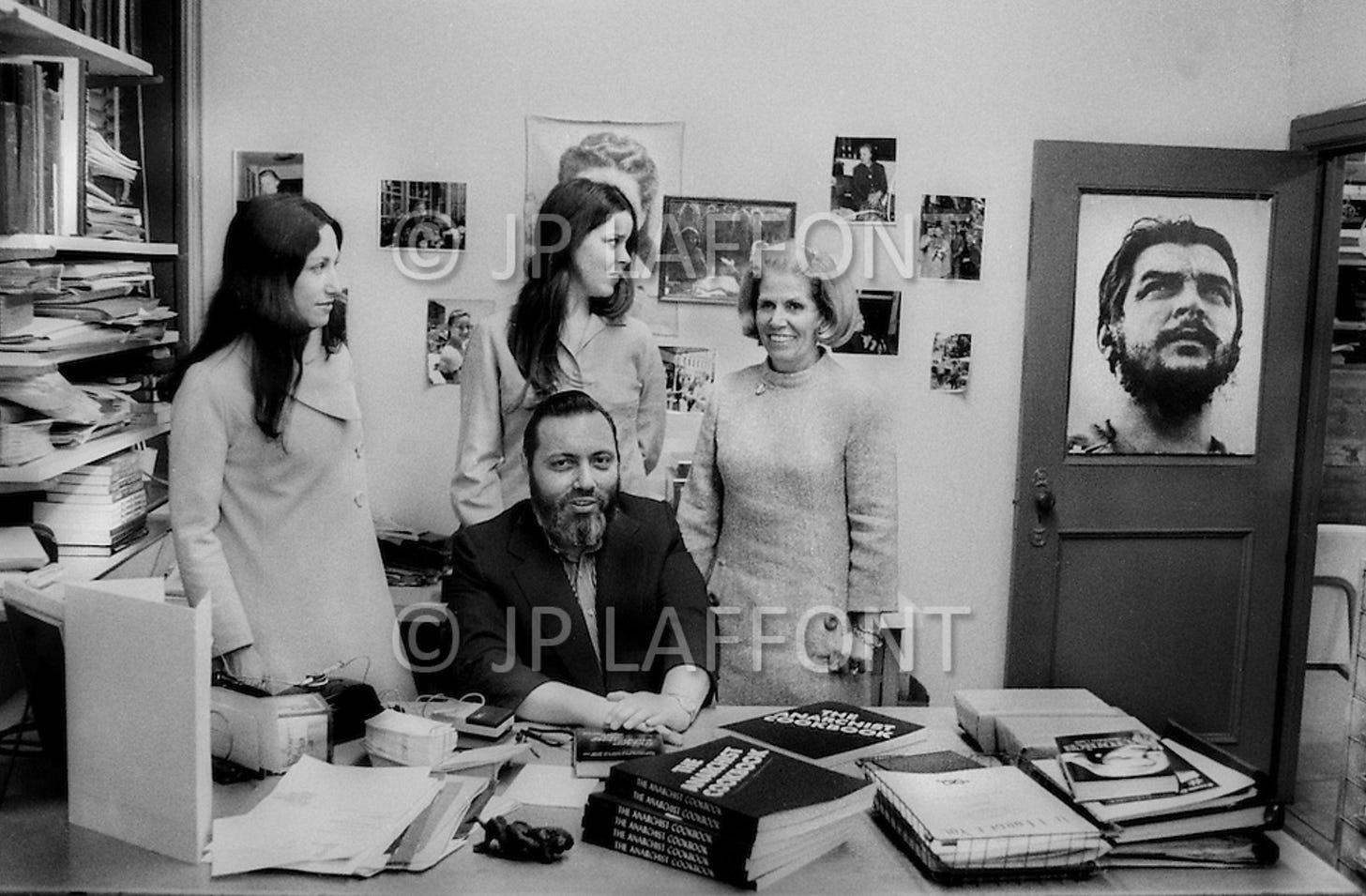
It was very possibly Lyle Stuart’s edition of the Cookbook that I read as a teenager although it might have been a samizdat xerox or similar. I can’t remember if the book was banned in the UK at that time or just something you hid from view. Its author William Powell later recanted the contents and tried to stop further publication.
So if we head back to the unlikely Ginsberg-Kupferberg authorship of Sex Songs, Lyle Stuart would certainly have been known to them, if not directly in person. He was one of those approached to do an American edition of William S. Burroughs’ The Naked Lunch and had also published The Village Square, a compilation of a column in The Village Voice by John Wilcock, one of the co-founders of the alternative newspaper. So Stuart had a foot in the underground - he certainly wasn’t The Man - and that poster of Che Guevara on his office door would have kept you guessing about his loyalties or motivations.
NOTE: It looks like Stuart’s papers are held at Columbia University, so anyone wondering where to look further and just maybe write more extensively should probably start there.
As I mentioned above, this is a two-part post. In the second, I’ll take a look inside the book. One further slight aspect to consider is the jacket design by Nick Frank. To suggest the purportedly ancient nature of these songs, Frank has quoted a Greek shaped lyre. I don’t know if this style of lyre has ever been popular in Latvia or not. It’s possible. The far better known stringed Latvian instrument is the kokle, a boxed zither, unlike the open backed lyre, which has its close equivalents in neighbouring Baltic nations as well as Russia. Those people on the album cover above are all playing the same. It can be both strummed and plucked. It also comes in a variety of sizes and number of strings. Modern versions are more orchestral in range whereas the early are more limited.
Basic.
Advanced.
Jazz.

